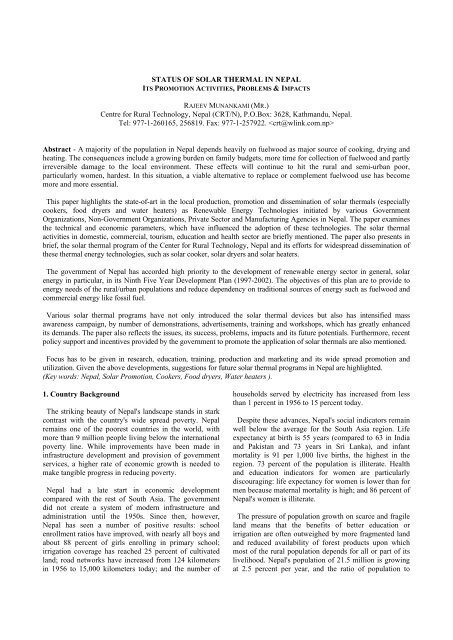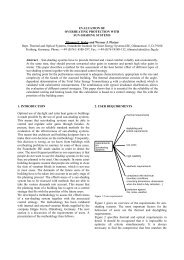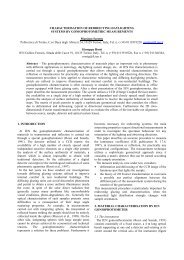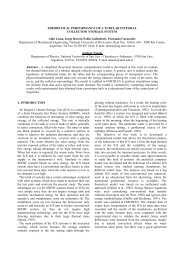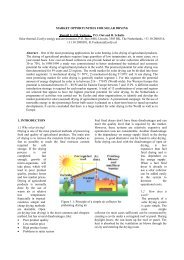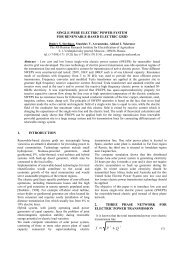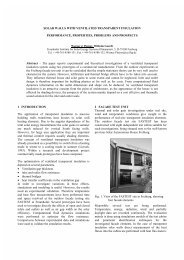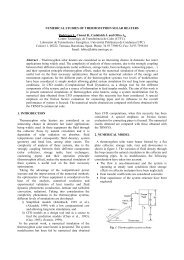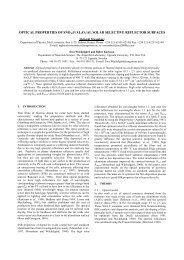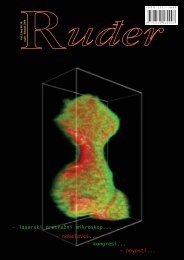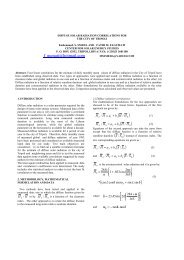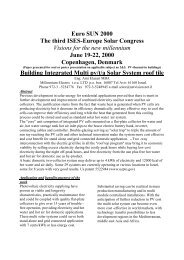Create successful ePaper yourself
Turn your PDF publications into a flip-book with our unique Google optimized e-Paper software.
STATUS OF SOLAR THERMAL IN NEPAL<br />
ITS PROMOTION ACTIVITIES, PROBLEMS & IMPACTS<br />
RAJEEV MUNANKAMI (MR.)<br />
Centre for Rural Technology, Nepal (CRT/N), P.O.Box: 3628, Kathmandu, Nepal.<br />
Tel: 977-1-260165, 256819. Fax: 977-1-257922. <br />
Abstract - A majority <strong>of</strong> the population <strong>in</strong> Nepal depends heavily on fuelwood as major source <strong>of</strong> cook<strong>in</strong>g, dry<strong>in</strong>g and<br />
heat<strong>in</strong>g. The consequences <strong>in</strong>clude a grow<strong>in</strong>g burden on family budgets, more time for collection <strong>of</strong> fuelwood and partly<br />
irreversible damage to the local environment. These effects will cont<strong>in</strong>ue to hit the rural and semi-urban poor,<br />
particularly women, hardest. In this situation, a viable alternative to replace or complement fuelwood use has become<br />
more and more essential.<br />
This paper highlights the state-<strong>of</strong>-art <strong>in</strong> the local production, promotion and dissem<strong>in</strong>ation <strong>of</strong> <strong>solar</strong> <strong>thermal</strong>s (especially<br />
cookers, food dryers and water heaters) as Renewable Energy Technologies <strong>in</strong>itiated by various Government<br />
Organizations, Non-Government Organizations, Private Sector and Manufactur<strong>in</strong>g Agencies <strong>in</strong> Nepal. The paper exam<strong>in</strong>es<br />
the technical and economic parameters, which have <strong>in</strong>fluenced the adoption <strong>of</strong> these technologies. The <strong>solar</strong> <strong>thermal</strong><br />
activities <strong>in</strong> domestic, commercial, tourism, education and health sector are briefly mentioned. The paper also presents <strong>in</strong><br />
brief, the <strong>solar</strong> <strong>thermal</strong> program <strong>of</strong> the Center for Rural Technology, Nepal and its efforts for widespread dissem<strong>in</strong>ation <strong>of</strong><br />
these <strong>thermal</strong> energy technologies, such as <strong>solar</strong> cooker, <strong>solar</strong> dryers and <strong>solar</strong> heaters.<br />
The government <strong>of</strong> Nepal has accorded high priority to the development <strong>of</strong> renewable energy sector <strong>in</strong> general, <strong>solar</strong><br />
energy <strong>in</strong> particular, <strong>in</strong> its N<strong>in</strong>th Five Year Development Plan (1997-2002). The objectives <strong>of</strong> this plan are to provide to<br />
energy needs <strong>of</strong> the rural/urban populations and reduce dependency on traditional sources <strong>of</strong> energy such as fuelwood and<br />
commercial energy like fossil fuel.<br />
Various <strong>solar</strong> <strong>thermal</strong> programs have not only <strong>in</strong>troduced the <strong>solar</strong> <strong>thermal</strong> devices but also has <strong>in</strong>tensified mass<br />
awareness campaign, by number <strong>of</strong> demonstrations, advertisements, tra<strong>in</strong><strong>in</strong>g and workshops, which has greatly enhanced<br />
its demands. The paper also reflects the issues, its success, problems, impacts and its future potentials. Furthermore, recent<br />
policy support and <strong>in</strong>centives provided by the government to promote the application <strong>of</strong> <strong>solar</strong> <strong>thermal</strong>s are also mentioned.<br />
Focus has to be given <strong>in</strong> research, education, tra<strong>in</strong><strong>in</strong>g, production and market<strong>in</strong>g and its wide spread promotion and<br />
utilization. Given the above developments, suggestions for future <strong>solar</strong> <strong>thermal</strong> programs <strong>in</strong> Nepal are highlighted.<br />
(Key words: Nepal, Solar Promotion, Cookers, Food dryers, Water heaters ).<br />
1. Country Background<br />
The strik<strong>in</strong>g beauty <strong>of</strong> Nepal's landscape stands <strong>in</strong> stark<br />
contrast with the country's wide spread poverty. Nepal<br />
rema<strong>in</strong>s one <strong>of</strong> the poorest countries <strong>in</strong> the world, with<br />
more than 9 million people liv<strong>in</strong>g below the <strong>in</strong>ternational<br />
poverty l<strong>in</strong>e. While improvements have been made <strong>in</strong><br />
<strong>in</strong>frastructure development and provision <strong>of</strong> government<br />
services, a higher rate <strong>of</strong> economic growth is needed to<br />
make tangible progress <strong>in</strong> reduc<strong>in</strong>g poverty.<br />
Nepal had a late start <strong>in</strong> economic development<br />
compared with the rest <strong>of</strong> South Asia. The government<br />
did not create a system <strong>of</strong> modern <strong>in</strong>frastructure and<br />
adm<strong>in</strong>istration until the 1950s. S<strong>in</strong>ce then, however,<br />
Nepal has seen a number <strong>of</strong> positive results: school<br />
enrollment ratios have improved, with nearly all boys and<br />
about 88 percent <strong>of</strong> girls enroll<strong>in</strong>g <strong>in</strong> primary school;<br />
irrigation coverage has reached 25 percent <strong>of</strong> cultivated<br />
land; road networks have <strong>in</strong>creased from 124 kilometers<br />
<strong>in</strong> 1956 to 15,000 kilometers today; and the number <strong>of</strong><br />
households served by electricity has <strong>in</strong>creased from less<br />
than 1 percent <strong>in</strong> 1956 to 15 percent today.<br />
Despite these advances, Nepal's social <strong>in</strong>dicators rema<strong>in</strong><br />
well below the average for the South Asia region. Life<br />
expectancy at birth is 55 years (compared to 63 <strong>in</strong> India<br />
and Pakistan and 73 years <strong>in</strong> Sri Lanka), and <strong>in</strong>fant<br />
mortality is 91 per 1,000 live births, the highest <strong>in</strong> the<br />
region. 73 percent <strong>of</strong> the population is illiterate. Health<br />
and education <strong>in</strong>dicators for women are particularly<br />
discourag<strong>in</strong>g: life expectancy for women is lower than for<br />
men because maternal mortality is high; and 86 percent <strong>of</strong><br />
Nepal's women is illiterate.<br />
The pressure <strong>of</strong> population growth on scarce and fragile<br />
land means that the benefits <strong>of</strong> better education or<br />
irrigation are <strong>of</strong>ten outweighed by more fragmented land<br />
and reduced availability <strong>of</strong> forest products upon which<br />
most <strong>of</strong> the rural population depends for all or part <strong>of</strong> its<br />
livelihood. Nepal's population <strong>of</strong> 21.5 million is grow<strong>in</strong>g<br />
at 2.5 percent per year, and the ratio <strong>of</strong> population to
arable land (around 600 persons per square kilometer) is<br />
one <strong>of</strong> the highest <strong>in</strong> the world. Of the 90 percent Nepal's<br />
population liv<strong>in</strong>g <strong>in</strong> rural areas, less than half has access<br />
to safe water, and less than 6 percent has access to<br />
sanitation. (source: World Bank document: np-countrybrief, 1998)<br />
2. Overview <strong>of</strong> Energy Scenario<br />
Energy problems <strong>of</strong> Nepal hardly differ from the ones<br />
encountered <strong>in</strong> other develop<strong>in</strong>g countries. Energy<br />
sources <strong>in</strong> Nepal can be broadly classified <strong>in</strong>to three<br />
groups: traditional (biomass), commercial and alternative<br />
energy. Nepal's rural populations have been meet<strong>in</strong>g their<br />
energy needs from traditional sources as fuelwood and<br />
other biomass resources. The use <strong>of</strong> modern forms <strong>of</strong><br />
energy- electricity, kerosene and diesel – is comparatively<br />
new, and <strong>in</strong> many rural areas they have yet to be<br />
<strong>in</strong>troduced.<br />
Two major characteristics <strong>of</strong> energy systems <strong>in</strong> Nepal<br />
are excessive dependence on biomass energy and low<br />
efficiency <strong>in</strong> its use. An excessive dependence on<br />
biomass energy <strong>in</strong>volves a trade-<strong>of</strong>f <strong>in</strong> agricultural<br />
productivity, the crop residues and animal wastes be<strong>in</strong>g<br />
diverted from farms, where they supplement soil<br />
nutrition, to stoves and hearths to provide heat energy<br />
needs. Diverse energy consumption patterns, due to<br />
different geographic, cultural and economic sett<strong>in</strong>gs and a<br />
very low level <strong>of</strong> energy consumption, as a result <strong>of</strong><br />
widespread poverty, are some <strong>of</strong> the other important<br />
characteristics. Other aspects that have direct and/or<br />
<strong>in</strong>direct implications on the economic and f<strong>in</strong>ancial<br />
viability <strong>of</strong> energy systems are people's <strong>in</strong>ability to afford<br />
commercial forms <strong>of</strong> energy and a lack <strong>of</strong> resources for<br />
proper development (Amatya & Shrestha 1998).<br />
Nepal's per capita annual energy consumption, 0.3 toe<br />
(14.06 GJ), is one <strong>of</strong> the lowest <strong>in</strong> the world. Per capita<br />
commercial energy consumption, 30kg <strong>of</strong> oil equivalent,<br />
is also very low compared to other countries <strong>of</strong> the sub<br />
region. However, the growth <strong>of</strong> commercial energy<br />
consumption has been high, about 8.4 percent per annum.<br />
The electricity supply is limited to about 14 percent <strong>of</strong> the<br />
total population. The rural population, which makes up<br />
about 90 percent <strong>of</strong> the total, has very limited access to<br />
electricity (Amatya 1997). The rural residential sector<br />
alone consumes about 84 percent <strong>of</strong> the total energy.<br />
However, if only commercial energy (<strong>in</strong>clud<strong>in</strong>g new and<br />
renewable energy) is considered, then this figure falls to<br />
only 45 percent (WECS 1997).<br />
In spite <strong>of</strong> large theoretical hydropower potential <strong>of</strong><br />
83,000MW, <strong>of</strong> which 42,000MW is established to be<br />
technically feasible, Nepal has developed only 250MW <strong>of</strong><br />
hydropower, which supplies about 1 percent <strong>of</strong> the total<br />
energy requirements (WECS 1994). Fuelwood accounts<br />
for 80 percent <strong>of</strong> energy consumption, and it is ma<strong>in</strong>ly<br />
consumed <strong>in</strong> rural Nepal (Amatya and Kharel 1997).<br />
Public, community, private forests and private land are<br />
the major sources <strong>of</strong> fuelwood. These resources are<br />
deplet<strong>in</strong>g rapidly as a result <strong>of</strong> overexploitation and lack<br />
<strong>of</strong> adequate management. Other biomass sourcesagricultural<br />
residue and animal waste provide for about<br />
10 percent <strong>of</strong> the energy requirement. Imported petroleum<br />
and coal together make up about 8 percent <strong>of</strong> the total<br />
consumption (Amatya and Shrestha 1998).<br />
Given the above scenario efforts have been made <strong>in</strong><br />
recent years both by the government and private sector to<br />
harness <strong>solar</strong> technology to reduce dependency on<br />
traditional sources <strong>of</strong> energy such as fuelwood and<br />
biomass resources to meet rural energy needs.<br />
3. Solar Energy Scene<br />
Nepal has a high potential for harness<strong>in</strong>g <strong>solar</strong> energy.<br />
As per an estimate by WECS (1995), 78 percent lies <strong>in</strong><br />
high potential <strong>solar</strong> <strong>in</strong>solation areas. The average<br />
<strong>in</strong>solation is around 4.5 kWh/m 2 /day and the sunsh<strong>in</strong>e for<br />
about 300 days per year are sufficient for most smallscale<br />
application. The monthly daily global <strong>solar</strong><br />
radiation varies from 120 to 260 w/m 2 with the annual<br />
sun sh<strong>in</strong>e duration rang<strong>in</strong>g from 1900 to 2500 hours<br />
(Rijal, 1984).<br />
Location<br />
Elevation <strong>in</strong><br />
Solar Radiation <strong>in</strong> Different Parts <strong>of</strong> Nepal<br />
Month<br />
meters 1 2 3 4 5 6 7 8 9 10 11 12<br />
Mahendra Nagar 176 320 395 475 530 529 435 392 390 392 378 346 304 6.64<br />
Surkhet 720 309 390 457 551 566 429 407 390 390 394 348 308 6.72<br />
Jumla 2300 293 359 428 515 545 522 413 395 410 378 339 295 6.65<br />
Lumle 1642 316 384 454 488 424 343 317 300 341 360 337 298 5.92<br />
Pokhara 627 305 373 437 478 429 375 359 335 350 357 338 299 6.03<br />
Bhairahawa 120 353 429 510 578 586 454 443 416 384 408 379 337 7.18<br />
Kathmandu 1367 319 336 445 494 487 379 343 331 370 376 347 310 6.23<br />
Okhaldhunga 1720 316 391 433 460 413 347 364 326 334 358 355 315 6.00<br />
Biratnagar 72 344 412 489 535 523 437 400 397 382 398 369 329 6.82<br />
Dharan 444 345 410 479 525 502 416 395 371 349 370 364 327 6.59<br />
(Source: Agro-Climatic Data, FAO Headquarters, Rome, Italy)<br />
Yearly<br />
Average<br />
<strong>in</strong> kwh/m 2 /day
4. Solar Thermal Activities <strong>in</strong> Nepal<br />
4.1 Solar Cooker<br />
Historical Background<br />
Development <strong>of</strong> <strong>solar</strong> cooker <strong>in</strong> Nepal started <strong>in</strong> 1977<br />
with the <strong>in</strong>troduction <strong>of</strong> parabolic cooker by Research<br />
Centre for Applied Science and Technology (RECAST).<br />
Later various types <strong>of</strong> <strong>solar</strong> cookers have been developed<br />
and dissem<strong>in</strong>ated by RECAST, Centre for Rural<br />
Technology Nepal (CRT/N) and few <strong>in</strong>dividuals.<br />
Current Status<br />
CRT/N has promoted about 2000 units <strong>of</strong> <strong>solar</strong> box<br />
cooker and about 150 <strong>solar</strong> parabolic cooker (SK-14).<br />
These cookers are used for boil<strong>in</strong>g water and cook<strong>in</strong>g<br />
daily foods. Solar cookers should be taken as a secondary<br />
means <strong>of</strong> cook<strong>in</strong>g due to uncerta<strong>in</strong>ty <strong>of</strong> good sunsh<strong>in</strong>e<br />
hours.<br />
Resources are be<strong>in</strong>g depleted rapidly by the growth <strong>of</strong><br />
tourism on trekk<strong>in</strong>g routes. To solve this situation <strong>solar</strong><br />
lightweight portable trekkers' cookers have been<br />
developed. (FAST, 1999)<br />
System be<strong>in</strong>g used <strong>in</strong> Nepal<br />
Solar cookers be<strong>in</strong>g used is parabolic type (German<br />
design) and different Box type. Fabrication <strong>of</strong> all these<br />
are done locally only the reflector sheet <strong>of</strong> SK-14 is be<strong>in</strong>g<br />
imported from Germany.<br />
Institutional Status<br />
• No specific policy/program <strong>of</strong> HMG <strong>of</strong> Nepal has<br />
been formulated for promotion <strong>of</strong> <strong>solar</strong> cooker.<br />
• Few NGOs [Alternative Energy Promotion Center<br />
(AEPC) prequalified organizations], especially<br />
CRT/N have been dissem<strong>in</strong>at<strong>in</strong>g this technology with<br />
limited success. But recently demands for <strong>solar</strong><br />
cookers are <strong>in</strong>creas<strong>in</strong>g nicely.<br />
F<strong>in</strong>ancial Mechanism<br />
Start<strong>in</strong>g with the fiscal year 1998, AEPC is provid<strong>in</strong>g 50<br />
percent government subsidy for the <strong>solar</strong> cookers.<br />
tra<strong>in</strong><strong>in</strong>g and development <strong>of</strong> <strong>solar</strong> cooker. CRT/N is<br />
arrang<strong>in</strong>g tra<strong>in</strong><strong>in</strong>g programs from with support from<br />
various donor agencies.<br />
Barrier <strong>in</strong> Promotion and Development<br />
The ma<strong>in</strong> barriers for promotion and commercialization<br />
<strong>of</strong> <strong>solar</strong> cookers are as follows:<br />
• Adherence <strong>of</strong> traditional cultural an eat<strong>in</strong>g habits.<br />
• Uncerta<strong>in</strong>ty <strong>of</strong> good sunsh<strong>in</strong>e hours <strong>in</strong> a day at the<br />
required time.<br />
• Lack <strong>of</strong> awareness and knowledge about the benefits<br />
<strong>of</strong> <strong>solar</strong> cookers.<br />
• Superstition <strong>of</strong> cook<strong>in</strong>g <strong>in</strong> the open where 'evil eye'<br />
can fall while cook<strong>in</strong>g makes people difficult to<br />
accept <strong>solar</strong> cookers for certa<strong>in</strong> caste <strong>of</strong> people.<br />
Future Strategy<br />
• R&D works should be carried out to develop a <strong>solar</strong><br />
cooker, which is technically mature, cost-efficient<br />
and durable.<br />
• A long-term awareness and dissem<strong>in</strong>ation program<br />
should be launched to popularize <strong>solar</strong> cookers.<br />
• Hotels, restaurants and guest houses should be<br />
encouraged to use <strong>solar</strong> cookers to preheat water, to<br />
pasteurize water and to prepare special <strong>solar</strong> cooked<br />
dishes.<br />
• Proper mass awareness and dissem<strong>in</strong>ation program<br />
should be launched on a long-term basis regard<strong>in</strong>g<br />
the use, ma<strong>in</strong>tenance and benefits <strong>of</strong> <strong>solar</strong> cook<strong>in</strong>g<br />
technology.<br />
• HMG <strong>of</strong> Nepal should morally and f<strong>in</strong>ancially<br />
support <strong>in</strong>stitutions work<strong>in</strong>g on the promotion and<br />
development <strong>of</strong> <strong>solar</strong> cook<strong>in</strong>g technology.<br />
• Education at appropriate levels should be given about<br />
<strong>solar</strong> cook<strong>in</strong>g technologies <strong>in</strong> the secondary and<br />
tertiary levels <strong>of</strong> education.<br />
• Vocational tra<strong>in</strong><strong>in</strong>g schools should be encouraged to<br />
impart fabricat<strong>in</strong>g and <strong>in</strong>stall<strong>in</strong>g skills related to <strong>solar</strong><br />
cookers<br />
• Follow up, monitor<strong>in</strong>g and market studies should be<br />
regularly undertaken to obta<strong>in</strong> the expectations,<br />
op<strong>in</strong>ions and suggestions <strong>of</strong> users.<br />
Human Resource Development<br />
No government or formal <strong>in</strong>stitution exists for the<br />
His Majesty's Government <strong>of</strong> Nepal<br />
N<strong>in</strong>th Five Year Plan (1997-2002)<br />
Development <strong>of</strong> Alternative Energy Goal<br />
Solar Energy<br />
Activities<br />
Unit<br />
Five Year Plan<br />
97/98 98/99 99/00 00/01 01/02<br />
Solar Dryer Installation (3 sq. m) Numbers 30 60 60 60 90 300<br />
Solar Energy Data<br />
Collection/Mapp<strong>in</strong>g<br />
Tra<strong>in</strong><strong>in</strong>g/Demonstration/Supervision/<br />
Research and Development<br />
Districts 1 4 5 5 5 20<br />
Districts<br />
(Source: N<strong>in</strong>th Five Year Plan Document HMG/N PP. 562)<br />
4 6 8 10 12 40<br />
Total
4.2 Solar Dryer<br />
Historical Background<br />
The simple and <strong>in</strong>expensive process <strong>of</strong> open sun dry<strong>in</strong>g<br />
is common <strong>in</strong> Nepal. Initially dur<strong>in</strong>g mid seventies<br />
RECAST <strong>in</strong>itiated R&D works on Solar Dryers. Later<br />
various private companies jo<strong>in</strong>ed the market under<br />
various development programs. Noteworthy to mention<br />
here is the pioneer<strong>in</strong>g works <strong>of</strong> the Technical University<br />
<strong>of</strong> Munich, Germany which <strong>in</strong> collaboration with<br />
RECAST <strong>in</strong>troduced tunnel type dryer <strong>in</strong> Marpha for<br />
apple dry<strong>in</strong>g <strong>in</strong> 1993.<br />
Current Status<br />
A recent study done by RECAST prelim<strong>in</strong>arily <strong>in</strong>dicates<br />
that about 14 districts <strong>of</strong> Nepal are us<strong>in</strong>g <strong>solar</strong> dryers.<br />
About 808 <strong>solar</strong> dryers are be<strong>in</strong>g used out <strong>of</strong> which 763<br />
are <strong>of</strong> box type, 37 are <strong>of</strong> cab<strong>in</strong>et type and 8 are <strong>of</strong> tunnel<br />
type.<br />
Earlier <strong>solar</strong> dryers were be<strong>in</strong>g used for dry<strong>in</strong>g fruits,<br />
vegetables and meat products. But currently these are also<br />
used for dry<strong>in</strong>g medic<strong>in</strong>al herbs, tree bark and herbarium<br />
plant specimen. Various organizations are dissem<strong>in</strong>at<strong>in</strong>g<br />
this technology for sett<strong>in</strong>g up a micro enterprise.<br />
System be<strong>in</strong>g used <strong>in</strong> Nepal<br />
Few manufacturers and NGOs have attempted to<br />
promote a few designs <strong>of</strong> <strong>solar</strong> dryers. A box-type <strong>solar</strong><br />
cab<strong>in</strong>et dryer developed at the Brace Research Institute<br />
and modified by RECAST is be<strong>in</strong>g used for dry<strong>in</strong>g<br />
vegetables and fruits such as apples, g<strong>in</strong>ger, banana,<br />
jackfruit and potato chips. A modified rack type <strong>solar</strong><br />
dryer developed by RECAST is also used for dry<strong>in</strong>g<br />
fruits and vegetables, herbal plants and tree bark.<br />
Institutional Status<br />
• In the n<strong>in</strong>th five-year (1997-2002) plan 300 units <strong>of</strong><br />
<strong>solar</strong> dryer (each hav<strong>in</strong>g a collector area <strong>of</strong> 3 sq. m)<br />
are planned.<br />
• First <strong>of</strong> all there is no formally registered Association<br />
<strong>of</strong> Manufacturers <strong>of</strong> <strong>solar</strong> dryers <strong>in</strong> Nepal which<br />
could really contribute to the healthy growth <strong>of</strong> this<br />
<strong>in</strong>dustry.<br />
Particular<br />
Solar Cooker<br />
Box Cooker<br />
Standard Size<br />
Available Subsidy for Solar Cookers and Dryers<br />
Price/Unit<br />
Subsidy (%)<br />
(NRs)<br />
• No government or semi government <strong>in</strong>stitution is<br />
look<strong>in</strong>g after the development <strong>of</strong> <strong>solar</strong> dryers.<br />
F<strong>in</strong>ancial Mechanism<br />
HMG <strong>of</strong> Nepal launched the subsidy program for <strong>solar</strong><br />
dryer through AEPC <strong>in</strong> the fiscal year 1997/98. From<br />
April 1998 to May 1999 AEPC provided subsidy to 58<br />
units <strong>of</strong> <strong>solar</strong> dryer. AEPC is currently provid<strong>in</strong>g 50<br />
percent subsidy to the <strong>solar</strong> dryer cost<strong>in</strong>g from Rs. 2000/-<br />
to a maximum <strong>of</strong> Rs. 20,000/- <strong>in</strong> case <strong>of</strong> tunnel type <strong>solar</strong><br />
dryer.<br />
Human Resource Development<br />
No specific <strong>in</strong>stitution is engaged <strong>in</strong> the tra<strong>in</strong><strong>in</strong>g aspects<br />
<strong>of</strong> <strong>solar</strong> dryers. A few tra<strong>in</strong><strong>in</strong>gs on fabrication and<br />
ma<strong>in</strong>tenance is provided by CRT/N and RECAST <strong>in</strong><br />
some selected program areas.<br />
Barriers <strong>in</strong> Promotion and Development<br />
The ma<strong>in</strong> barriers for promotion and development <strong>of</strong><br />
<strong>solar</strong> dryers are as follows:<br />
• Absence <strong>of</strong> <strong>in</strong>tegrated development approach.<br />
• Absence <strong>of</strong> the required R&D works to develop<br />
product specific low cost <strong>solar</strong> dryers for commercial<br />
purposes.<br />
• Lack <strong>of</strong> awareness and tra<strong>in</strong><strong>in</strong>g program.<br />
• Lack <strong>of</strong> specific plans/programs for the development<br />
and dissem<strong>in</strong>ation <strong>of</strong> <strong>solar</strong> dry<strong>in</strong>g technology.<br />
Remarks<br />
Wooden Box 2,400/- 50 Maximum Subsidy per Unit<br />
(size 2.5 sq. ft)<br />
Parabolic SK-14<br />
7,500/- 50 Maximum Subsidy per Unit<br />
Diameter 1.4m<br />
Solar Dryer<br />
Tunnel Type 24 sq. ft 20,000/- 50 Maximum Subsidy per Unit<br />
(Force Draft)<br />
Cab<strong>in</strong>et Type 12 sq. ft 2,000/- 50 Maximum Subsidy per Unit<br />
Rack Type Effective Tray 8,000/- NA<br />
area 1.44 sq. m
• Poor monitor<strong>in</strong>g and evaluation works.<br />
• Lack <strong>of</strong> standard for quality control and<br />
recommended practices for <strong>solar</strong> dryers.<br />
• Poor arrangements for the market<strong>in</strong>g and f<strong>in</strong>anc<strong>in</strong>g<br />
<strong>of</strong> <strong>solar</strong> dried products.<br />
Future Strategy<br />
• Solar dryers should be designed and fabricated tak<strong>in</strong>g<br />
<strong>in</strong>to consideration the relevant parameters needed for<br />
regulation dur<strong>in</strong>g the dehydration process based upon<br />
sound food technology practices.<br />
• Adequate R&D works should be carried out on the<br />
l<strong>in</strong>kages between the agricultural crop cycle and the<br />
<strong>solar</strong> dry<strong>in</strong>g technology.<br />
• Suitable codes <strong>of</strong> standardization and quality control<br />
measures should be developed.<br />
• Proper mass awareness and dissem<strong>in</strong>ation program<br />
should be launched on a long-term basis regard<strong>in</strong>g<br />
the use, ma<strong>in</strong>tenance and benefits <strong>of</strong> <strong>solar</strong> dry<strong>in</strong>g<br />
technology.<br />
• HMG <strong>of</strong> Nepal should morally and f<strong>in</strong>ancially<br />
support <strong>in</strong>stitutions work<strong>in</strong>g on the promotion and<br />
development <strong>of</strong> <strong>solar</strong> dry<strong>in</strong>g technology.<br />
• AEPC should facilitate, monitor and coord<strong>in</strong>ate the<br />
various R&D, quality control, HRD program and<br />
dissem<strong>in</strong>ation works related to the <strong>solar</strong> dryer<br />
technology.<br />
• Nepal Bureau <strong>of</strong> standards and Metrology should<br />
develop relevant standards/recommended practices<br />
for <strong>solar</strong> dry<strong>in</strong>g technology.<br />
• Education at appropriate levels should be given about<br />
<strong>solar</strong> dry<strong>in</strong>g technologies <strong>in</strong> the secondary and<br />
tertiary levels <strong>of</strong> education.<br />
• Vocational tra<strong>in</strong><strong>in</strong>g schools should be encouraged to<br />
impart fabricat<strong>in</strong>g and <strong>in</strong>stall<strong>in</strong>g skills related to <strong>solar</strong><br />
dryers.<br />
4.3 Solar Water Heaters (SWHs)<br />
Historical Background<br />
The development <strong>of</strong> SWHs <strong>in</strong> Nepal started around 1968<br />
with the manufacture <strong>of</strong> first prototype SWH by Late<br />
Rev. B. R. Saubolle and Asha Brothers <strong>in</strong> Kathmandu. In<br />
autumn <strong>of</strong> 1974, Plumb<strong>in</strong>g Division <strong>of</strong> Balaju Yanta Sala<br />
(BYS) made a pilot SWH from an old electric hot water<br />
tank and a small self-made collector. After considerable<br />
experiments improved SWHs were supplied to board<strong>in</strong>g<br />
school <strong>in</strong> Buddhanilkantha, Kathmandu. The<br />
development <strong>of</strong> SWHs received further support at the<br />
then newly established Sanitary Section <strong>of</strong> the<br />
Mechanical Tra<strong>in</strong><strong>in</strong>g Centre <strong>in</strong> Balaju with supports from<br />
Helvetas <strong>of</strong> Switzerland.<br />
Current Status<br />
An estimated 20,000 households have <strong>in</strong>stalled SWH for<br />
domestic purpose. While this makes less than 0.5 percent<br />
<strong>of</strong> the total households <strong>in</strong> the country, Nepal is considered<br />
one <strong>of</strong> the countries with the highest adoption <strong>of</strong> this<br />
technology. Around 2000 new systems are primarily<br />
be<strong>in</strong>g <strong>in</strong>stalled <strong>in</strong> newly built middle class homes. The<br />
sector is propelled forward by <strong>status</strong> symbol as much as<br />
utility (Pandey 2000).<br />
Kathmandu district accounts for around 80 percent <strong>of</strong><br />
these systems followed by Lalitpur, Pokhara and<br />
Bhaktapur. Almost all <strong>in</strong>stallations are with<strong>in</strong> the<br />
municipalities <strong>of</strong> these districts. Among commercial<br />
users, hotels are the primary users <strong>of</strong> SWH. The <strong>in</strong>dustrial<br />
sector is practically a non user. Among hotels, the more<br />
expensive 'star' rated hotels use less <strong>solar</strong> heated water<br />
than the non-star rated hotels (WECS 1998). The WECS<br />
study reports that while 33 percent <strong>of</strong> the star hotels have<br />
SWHs, <strong>in</strong> the non-star category, the percentage is much<br />
higher, 60 percent <strong>of</strong> those <strong>in</strong> Kathmandu and 83 percent<br />
<strong>in</strong> Pokhara have SWHs. Certa<strong>in</strong> lodges and hotels along<br />
trekk<strong>in</strong>g routes especially <strong>in</strong> Everest, Annarpurna and<br />
Langtang areas have adopted this technology. Adoption<br />
<strong>of</strong> SWH among educational and health <strong>in</strong>stitution is not<br />
high, less than 20 percent <strong>of</strong> schools and negligible<br />
among hospitals.<br />
It is estimated that there are around 200 manufacturers<br />
<strong>of</strong> SHWs <strong>in</strong> Nepal, primarily <strong>in</strong> the urban areas like<br />
Kathmandu and Pokhara. Around 35 SWH manufacturers<br />
registered with Department <strong>of</strong> Cottage and Small<br />
Industries. In addition to this it is estimated around 80-90<br />
unregistered manufacturers with<strong>in</strong> Kathmandu valley and<br />
likely to be similar number outside the valley as well,<br />
which are seasonal constructors and make other products<br />
dur<strong>in</strong>g non-w<strong>in</strong>ter month. S<strong>in</strong>ce the manufactur<strong>in</strong>g is<br />
simple and can be done by rudimentary metal workshops,<br />
there is no exact count <strong>of</strong> the number <strong>of</strong> actual<br />
manufacturers.<br />
There are variations <strong>in</strong> designs but despite the long<br />
period <strong>of</strong> use <strong>in</strong> Nepal, the locally manufactured SWHs<br />
are technically not <strong>in</strong> a very advanced stage. Thermo<br />
siphon type is the only type manufactured and marketed<br />
<strong>in</strong> commercial scale. The buyers have no choice as to the<br />
type <strong>of</strong> coat<strong>in</strong>g, and it is difficult, if not impossible, to get<br />
the standard performance curve from the manufacturers.<br />
The problems could be due to lack <strong>of</strong> market demand for<br />
sophisticated models, the need to keep the cost to<br />
m<strong>in</strong>imum, lack <strong>of</strong> appropriate materials and so on. About<br />
20 units <strong>of</strong> Australian made sophisticated imported<br />
Solahart brand SWHs have also been sold and used <strong>in</strong><br />
Kathmandu, which uses closed system with an anti-freeze<br />
liquid for us<strong>in</strong>g <strong>in</strong> freez<strong>in</strong>g climates.<br />
The technical performance <strong>of</strong> the collecters and SWHs<br />
are given only <strong>in</strong> terms <strong>of</strong> maximum outlet temperature <strong>of</strong><br />
hot water. The absence <strong>of</strong> detail technical characteristics<br />
<strong>of</strong> the system <strong>of</strong>ten h<strong>in</strong>ders the design <strong>of</strong> Solar heat<strong>in</strong>g<br />
systems us<strong>in</strong>g the SWHs.
System be<strong>in</strong>g used <strong>in</strong> Nepal<br />
Stationary Flat Plate Collector<br />
As the name suggests, it is just a stationary flat plate<br />
seen around the town <strong>in</strong> use with SHWs. The essential<br />
components <strong>of</strong> this are: <strong>solar</strong> radiation absorb<strong>in</strong>g surface<br />
(black pa<strong>in</strong>ted sheet) with the means for transferr<strong>in</strong>g the<br />
absorbed energy to fluid, fluid conduit, glaz<strong>in</strong>g, <strong>in</strong>sulation<br />
and the cas<strong>in</strong>g (collector box). The collector forms a<br />
major component <strong>of</strong> a system consist<strong>in</strong>g <strong>of</strong> an <strong>in</strong>sulated<br />
tank, water feed system, stand, pipe work, valves and an<br />
auxiliary heater as optional items. This collector rema<strong>in</strong>s<br />
fixed to the <strong>in</strong>itially <strong>in</strong>stalled direction and angles and<br />
obviously cannot track the sun for hav<strong>in</strong>g the best angle<br />
for direct <strong>solar</strong> radiation. The advantage <strong>of</strong> this type <strong>of</strong><br />
collector is the low cost and ease <strong>of</strong> ma<strong>in</strong>tenance and the<br />
disadvantage is the low efficiency compared to the other<br />
types <strong>of</strong> the collectors.<br />
Even after <strong>in</strong>troduc<strong>in</strong>g SWHs before 30 years ago no<br />
major change has been <strong>in</strong>troduced to date <strong>in</strong> the SHWs.<br />
The track<strong>in</strong>g system which tracks the Sun from the<br />
morn<strong>in</strong>g to even<strong>in</strong>g to receive the direct radiation at the<br />
best angle to its surface was also unsuccessful due to its<br />
high cost. Instead auxiliary systems like electric heaters<br />
have been <strong>in</strong>corporated <strong>in</strong> many SWHs.<br />
Institutional Status<br />
• First <strong>of</strong> all there is no formally registered Association<br />
<strong>of</strong> Manufacturers <strong>of</strong> SWHs <strong>in</strong> Nepal which could<br />
really contribute to the healthy growth <strong>of</strong> this<br />
<strong>in</strong>dustry.<br />
• No government or semi government <strong>in</strong>stitution is<br />
look<strong>in</strong>g after the development <strong>of</strong> SWHs.<br />
• No specific policy and program <strong>of</strong> HMG <strong>of</strong> Nepal<br />
exists for development and promotion <strong>of</strong> SWH<br />
technology.<br />
• Various INGOs, NGOs and lodge owners are<br />
dissem<strong>in</strong>at<strong>in</strong>g this technology specially for heat<strong>in</strong>g<br />
water for tourist showers.<br />
• High <strong>in</strong>itial cost. The current models are favorable to<br />
high-<strong>in</strong>come households thereby limit<strong>in</strong>g its<br />
adaptation by poor/disadvantage households.<br />
• Lack <strong>of</strong> awareness and knowledge about the<br />
applications and benefits <strong>of</strong> SWHs.<br />
• Lack <strong>of</strong> standard for quality control and<br />
recommended practices for SWHs.<br />
• Lack <strong>of</strong> subsidy as well as f<strong>in</strong>ancial <strong>in</strong>centives to the<br />
users/manufacturers <strong>of</strong> SWHs.<br />
• Use <strong>of</strong> subsidized kerosene for fir<strong>in</strong>g boilers by<br />
hotels and other <strong>in</strong>dustries has not been prohibited by<br />
HMG <strong>of</strong> Nepal.<br />
• Lack <strong>of</strong> R&D and HRD activities for SWH<br />
technology.<br />
• Lack <strong>of</strong> technical manpower.<br />
• Lack <strong>of</strong> proper monitor<strong>in</strong>g and evaluation work.<br />
Future Strategy<br />
• R&D activities should be conducted by various<br />
<strong>in</strong>stitutions to develop low cost SWH us<strong>in</strong>g locally<br />
available materials thereby help<strong>in</strong>g its adaptation by<br />
poor households and also for use <strong>in</strong> tourist areas with<br />
w<strong>in</strong>ter freez<strong>in</strong>g temperatures.<br />
• Introduction <strong>of</strong> proven technology like selective<br />
coat<strong>in</strong>g and copper absorber pipes should be<br />
<strong>in</strong>troduced.<br />
• Proper mass awareness campaign and dissem<strong>in</strong>ation<br />
program should be launched for use and ma<strong>in</strong>tenance<br />
<strong>of</strong> SWH giv<strong>in</strong>g emphasis to the energy sav<strong>in</strong>g aspect<br />
<strong>of</strong> this device.<br />
• HMG <strong>of</strong> Nepal should morally and f<strong>in</strong>ancially<br />
support <strong>in</strong>stitutions work<strong>in</strong>g on the promotion and<br />
development <strong>of</strong> SWH technology.<br />
• Nepal Bureau <strong>of</strong> Standards and Metrology should<br />
develop relevant standards/recommended practices<br />
for SWH technology.<br />
• Legal provision to provide tax and fiscal <strong>in</strong>centives<br />
for the user <strong>of</strong> SWH e.g. rebate <strong>in</strong> property tax and<br />
fee for construct<strong>in</strong>g new homes would greatly<br />
accelerate <strong>in</strong>stallation <strong>of</strong> SWHs.<br />
F<strong>in</strong>ancial Mechanism<br />
There is no subsidy from the government or loan facility<br />
from the banks to the users or manufacturers <strong>of</strong> SWH.<br />
However, without any subsidy or support from the<br />
government this technology grew relatively fast and<br />
deeply penetrated <strong>in</strong>to the private sector.<br />
Human Resource Development<br />
Balaju Technical Tra<strong>in</strong><strong>in</strong>g Centre, Kathmandu provides<br />
tra<strong>in</strong><strong>in</strong>gs on SWH. Various local manufacturers also<br />
provide repair and ma<strong>in</strong>tenance tra<strong>in</strong><strong>in</strong>gs to the users<br />
basically through the NGOs.<br />
Barriers <strong>in</strong> Promotion<br />
The ma<strong>in</strong> barriers for commercialization <strong>of</strong> SWH<br />
technology are the follow<strong>in</strong>g:<br />
Solar Water Heater <strong>in</strong> Kagbeni, Mustang.
5. Centre for Rural Technology Nepal (CRT/N) and<br />
its Solar Thermal Activities<br />
CRT/N is a pr<strong>of</strong>essional non-government organization<br />
engaged <strong>in</strong> develop<strong>in</strong>g and promot<strong>in</strong>g appropriate<br />
technologies effective <strong>in</strong> meet<strong>in</strong>g the basic needs <strong>of</strong> the<br />
rural mass and improv<strong>in</strong>g their life support systems.<br />
Initially it was established <strong>in</strong> August 1989 under the<br />
Company Act. It has now been registered with HMG/N<br />
under the Society Registration Act from October 1998 as<br />
a non-government organization.<br />
CRT/N adopts a participatory technology development<br />
approach whereby the users, community leaders,<br />
entrepreneurs and promoters work together and share<br />
ideas, experiences and views regard<strong>in</strong>g the technology <strong>in</strong><br />
concern.<br />
CRT/N had been dissem<strong>in</strong>at<strong>in</strong>g <strong>solar</strong> <strong>thermal</strong><br />
technologies especially cookers and dryers for number <strong>of</strong><br />
years. The activities undertaken by CRT are:<br />
• Fabrication and test<strong>in</strong>g <strong>of</strong> <strong>solar</strong> cookers and dryers<br />
made from different locally available materials<br />
• Organize several public demonstrations <strong>in</strong> order to<br />
create mass awareness among the urban and rural<br />
communities <strong>in</strong> collaboration with donor and l<strong>in</strong>e<br />
agencies.<br />
• Conduct tra<strong>in</strong><strong>in</strong>g for manufacturers, promoters,<br />
community workers and community members about<br />
the advantages, fabrication and use <strong>of</strong> <strong>solar</strong> dryers<br />
and cookers.<br />
• Publication <strong>of</strong> various promotional materials and<br />
tra<strong>in</strong><strong>in</strong>g manuals on <strong>solar</strong> cookers and dryers.<br />
• R&D work <strong>in</strong> collaboration with <strong>solar</strong> expert from<br />
Solar Barbeque, Australia.<br />
• Orientation/Demonstration <strong>of</strong> Solar Cook<strong>in</strong>g<br />
Technology for School Students <strong>of</strong> Kathmandu<br />
Valley with fund<strong>in</strong>g support <strong>of</strong> LHWfN e.v.<br />
• Promotion <strong>of</strong> Solar Dryer <strong>in</strong> Everest region with<br />
fund<strong>in</strong>g support <strong>of</strong> WWF-Nepal.<br />
• Promotion <strong>of</strong> <strong>solar</strong> cook<strong>in</strong>g activities <strong>in</strong> Bhutanese<br />
Refugee Camp <strong>in</strong> collaboration with Vajra<br />
Foundation - The Netherland.<br />
6. Few Case Stories<br />
Case Stories 1<br />
Mrs. Ratna Lama, a housewife, from Chandralalpur VDC,<br />
ward no 7 <strong>in</strong> Siraha district lives with two children and her<br />
husband. Her ma<strong>in</strong> occupation is farm<strong>in</strong>g and was th<strong>in</strong>k<strong>in</strong>g<br />
<strong>of</strong> some other extra bus<strong>in</strong>ess to support her family. With this<br />
view, she contacted Save the Children/US (SC/US) at<br />
Golbazar near her village. SC/US gave her the suggestion to<br />
keep a <strong>solar</strong> dryer to dry vegetables and fruits, which can be<br />
used dur<strong>in</strong>g <strong>of</strong>f-season. For that, she needs tra<strong>in</strong><strong>in</strong>g on the<br />
<strong>solar</strong> dry<strong>in</strong>g technology. She decided to form a committee <strong>of</strong><br />
ten women; which had the chance to take the tra<strong>in</strong><strong>in</strong>g on<br />
operation, use and fabrication <strong>of</strong> <strong>solar</strong> dryer <strong>in</strong> January 1995.<br />
After this tra<strong>in</strong><strong>in</strong>g, her group contributed Rs. 200 each to<br />
keep a <strong>solar</strong> dryer. The committee members are runn<strong>in</strong>g this<br />
project very smoothly. The group has expanded their<br />
projects <strong>in</strong> later stage by add<strong>in</strong>g other forms <strong>of</strong> cottage<br />
<strong>in</strong>dustry like prepar<strong>in</strong>g mattress, cap and bags from a grass<br />
called vetiver. For their <strong>in</strong>vestments they used the pr<strong>of</strong>it<br />
made dur<strong>in</strong>g their <strong>solar</strong> dryer activities.<br />
By the success <strong>of</strong> this group 6 more such groups were<br />
formed. Women groups were fully satisfied by this<br />
technology because they are produc<strong>in</strong>g the dried vegetable<br />
for <strong>of</strong>f season use as well as sales <strong>in</strong> the market. When they<br />
are busy <strong>in</strong> plant<strong>in</strong>g rice they have to hire labor and for them<br />
they have to serve food and money i.e. up to Rs. 75 per day.<br />
S<strong>in</strong>ce at that time the price vegetables is high, they can save<br />
money by us<strong>in</strong>g their own dried vegetables. Use they sell 25<br />
percent <strong>of</strong> the dried product <strong>in</strong> the local market as well as<br />
send to Women Entrepreneurs Association Nepal (WEAN)<br />
cooperative that sells the product for them.<br />
(Ms. Karuna Bajracharya, 1997. 'A case study on the<br />
application <strong>of</strong> an Environmentally Sound Technology (EST) at<br />
small scale enterprises <strong>in</strong> Nepal')<br />
Case Stories 2<br />
Chadani Rajbhandari, resident <strong>of</strong> Devpatan, Kathmandu,<br />
bought a parabolic cooker (SK-14) on April 1998 after she<br />
realized its advantages. She had seen the cooker be<strong>in</strong>g used<br />
so well <strong>in</strong> her relative.<br />
Chadani uses <strong>solar</strong> cooker every day for boil<strong>in</strong>g water. On<br />
weekends she uses it to cook rice, dal, meat curry,<br />
vegetables and to boil eggs. Now she is happy because it<br />
takes about 45 m<strong>in</strong>utes (<strong>in</strong> average) to boil 10 liters <strong>of</strong> water<br />
<strong>in</strong> sunny days from which she is sav<strong>in</strong>g fuel (LPG).<br />
Before, one cyl<strong>in</strong>der <strong>of</strong> LPG used to run only for about 21<br />
days but after br<strong>in</strong>g<strong>in</strong>g parabolic cooker <strong>in</strong> use it is sufficient<br />
for about 31 days. This shows that the gas could be used for<br />
extra 10 days. In terms <strong>of</strong> LP Gas cyl<strong>in</strong>der she needs about<br />
1.43 cyl<strong>in</strong>der <strong>of</strong> gas per month that cost around Rs 664.95<br />
per month and now she needs only 0.97 cyl<strong>in</strong>der <strong>of</strong> gas per<br />
month which cost only Rs. 451.05 per month after us<strong>in</strong>g<br />
<strong>solar</strong> cooker.<br />
Chadani also owns a sweet shop. In order to prepare the<br />
sweets she used to need about 8 liters <strong>of</strong> kerosene every<br />
week. But now after us<strong>in</strong>g the <strong>solar</strong> parabolic cooker she<br />
saves about 2 liters. The cooker is also used to boil water<br />
and melt ghee required for the shop.<br />
She says that the <strong>solar</strong> cooked food is tasty. She also says<br />
that she is suggest<strong>in</strong>g her neighbors and friends to use <strong>solar</strong><br />
cooker to save fuel and money.<br />
(Ms. Sama Shrestha, 1999. 'Teach<strong>in</strong>g and Tra<strong>in</strong><strong>in</strong>g<br />
Communities <strong>of</strong> Kathmandu Valley <strong>in</strong> the use <strong>of</strong> Solar Parabolic<br />
Cookers'.)
7. Conclusion<br />
Solar <strong>thermal</strong> technology is a proven technology and can<br />
be operated <strong>in</strong> almost all the regions <strong>of</strong> Nepal. Nepal's<br />
major rural populations do not have access to national<br />
grid. The feasible approach to supplement fuel for dry<strong>in</strong>g,<br />
cook<strong>in</strong>g and heat<strong>in</strong>g to remote locations <strong>in</strong> a reasonable<br />
time frame is with development and dissem<strong>in</strong>ation <strong>of</strong><br />
renewable energy options specially decentralized small<br />
size <strong>solar</strong> <strong>thermal</strong> systems that can be f<strong>in</strong>anced and<br />
ma<strong>in</strong>ta<strong>in</strong>ed by the local population. Solar <strong>thermal</strong><br />
processes like cook<strong>in</strong>g, dry<strong>in</strong>g and water heat<strong>in</strong>g could be<br />
a very effective means for reduc<strong>in</strong>g the current pressure<br />
on already deplet<strong>in</strong>g natural resources. However, much<br />
more efforts are required for creat<strong>in</strong>g mass awareness on<br />
these technologies and their use through<br />
orientation/demonstration activities as well as proper<br />
strategies for technology transfer through tra<strong>in</strong><strong>in</strong>g<br />
activities and design development. These technologies are<br />
cost effective and provide a susta<strong>in</strong>able technology for<br />
rural areas if appropriate knowledge on the production<br />
and the uses could be promoted with the use <strong>of</strong> local<br />
materials and skill.<br />
Selected References:<br />
Amatya V. B. & Shrestha G. R. (1998) 'Review on<br />
Policies and Their implications on Renewable Energy<br />
Technologies <strong>in</strong> Nepal'. Report prepared for ICIMOD.<br />
Kathmandu: CRT.<br />
Amatya V. B. (1997) 'Energy Updates'. In WECS<br />
Bullet<strong>in</strong>, Vol. 8, No. 1 Kathmandu: WECS, HMG/N<br />
Amatya V. B. & Kharel D. K. (1997) 'Energy from<br />
Biomass: Present Status <strong>in</strong> Nepal'. In WECS Bullet<strong>in</strong>,<br />
Vol. 8. No. 3 Kathmandu: WECS, HMG/N<br />
CES (2000) 'Renewable Energy Perspective Plan:<br />
Sectoral Report' Kathmandu<br />
Pandey B. (2000) 'Renewable Energy Support Option'<br />
Kathmandu: RESPO/WINROCK<br />
Rijal K. (1984) 'Availability <strong>of</strong> Solar Energy <strong>in</strong> Nepal'.<br />
Kathmandu: WECS, HMG/N<br />
WECS (1994) 'Energy Sector Synopsis Report 1992/93'.<br />
Kathmandu WECS, HMG/N<br />
WECS (1997) 'Inventry on Solar Water Heat<strong>in</strong>g System<br />
and its Technological Assesment for household Adoption<br />
<strong>in</strong> Nepal.<br />
Various types <strong>of</strong> Solar Cookers and Dryers dur<strong>in</strong>g Exhibition


